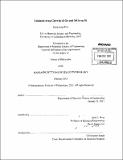Limited-area growth of Ge and SiGe on Si
Author(s)
Kim, Meekyung, Ph. D. Massachusetts Institute of Technology
DownloadFull printable version (24.10Mb)
Other Contributors
Massachusetts Institute of Technology. Dept. of Materials Science and Engineering.
Advisor
Judy L Hoyt.
Terms of use
Metadata
Show full item recordAbstract
The goal of this thesis is to develop and understand processing conditions that improve the surface morphology and reduce the dislocation density in limited-area heteroepitaxy of Ge and SiGe on Si (100) substrates. Low pressure chemical vapor deposition was investigated for two limiting cases of strain states: thin, strained, high Ge content SiGe films for transistor applications, and thick, relaxed Ge films, for potential optoelectronic applications. Selective epitaxial growth of thin, high Ge-content, strained SiGe on oxide-patterned silicon was studied, specifically the effect of growth area on the critical thickness. The critical thickness of Sio.33Geo.67 formed by selective epitaxial growth in areas of 2.3 x 2.3 [mu]m was found to be 8.5 nm, which is an increase of 2x compared to the critical thickness observed for growth in large areas (i.e. for non-selective epitaxy). The sources of misfit dislocation nucleation in selective growth were analyzed, and misfit generation from the SiGe pattern edges, due to effects such as local strain concentration, Si surface shape near the oxide boundary, and preferential SiGe growth near the pattern edge were investigated. Thin, smooth Ge-on-Si films were developed and the effect of growth conditions on film morphology was examined to find an optimum temperature and pressure for smooth film surface (365 °C and 60 torr). A period of delayed epitaxial growth, or "incubation time" was observed, and a Si surface treatment technique, consisting of a short SiGe pulse, with negligible SiGe thickness, was employed to realize uniform Ge films with low surface roughness (RMS<0.3 nm) and reduced incubation time (<20 seconds). For selective growth of relaxed, thick Ge, approximately 1 pm-thick Ge films were grown in exposed Si regions on oxide-patterned wafers, and germanium selectivity, faceting, surface roughness and threading dislocation density were studied as functions of growth and processing conditions. The optimal growth condition for relaxed Ge selective epitaxial growth was found (750 °C and 10 torr, with 100 sccms of GeH4 and 10 slpm H2 flow), and the effect of thermal annealing, Ge film thickness, and growth area on the threading dislocation density was also studied.
Description
Thesis (Ph. D.)--Massachusetts Institute of Technology, Dept. of Materials Science and Engineering, 2011. Cataloged from PDF version of thesis. Includes bibliographical references (p. 147-159).
Date issued
2011Department
Massachusetts Institute of Technology. Department of Materials Science and EngineeringPublisher
Massachusetts Institute of Technology
Keywords
Materials Science and Engineering.